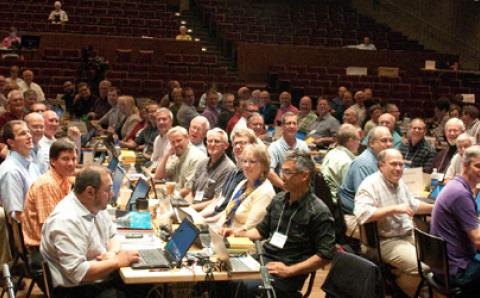The Specialized Ministries of the Christian Reformed Church often work quietly in the background, addressing issues that are important to the church.
In this issue, we feature stories about several of these ministries. These stories include
- the Timothy Christian School controversy of the late 1960s that led to the formation of today's Office of Race Relations;
- an initiative by Chaplaincy and Care Ministry that aims to more closely connect CRC chaplains and their supporting churches;
- a woman who lives with disabilities and has become a leader in her congregation with the help of Disability Concerns and her church;
the advocacy work the Office of Social Justice is doing on the issue of immigration.
Lynn stepped off the school bus in September 1967 and walked into Des Plaines Christian Elementary School along with nearly 20 other students from Lawndale Christian Reformed Church.
This was the seventh-grader’s first day at the school, and she was scared. All of them were. They had no idea how they would be treated at this school 28 miles from their urban Chicago church.
“I thought they would put me last in line,” Lynn wrote later in a school paper. “I thought that they wouldn’t talk to me. They would call me black.”
Almost right away, she says, she felt accepted. Still, she couldn’t forget why the students had to make that nearly 60-mile round-trip bus ride.
Lynn’s parents, as well as other parents, had applied to have their children attend Timothy Christian School in the community of Cicero, Ill., about three miles from their church. But they were repeatedly turned down. They were convinced it was because of their race.
“I had a grudge,” Lynn said. “Education was a mere stage I had to go through because I thought the whites would never let us prove what we knew.”
At Des Plaines Christian School, her attitude changed.
“Des Plaines has helped me to change my thoughts through the grace of God,” she wrote. “And I thank him for letting me be here.”
Lynn was part of a story that still echoes down the decades, rife with disturbing lessons and significant developments for the Christian Reformed Church.
The story took place in the 1960s during a time of great social upheaval in the United States over civil rights. Some 45 years ago this June, the issue of blacks being barred from the school came before Synod 1968.
Synod’s action included starting a process that eventually led to the creation of the current Office of Race Relations. But the road was long, complex, and painful.
Lawndale CRC, formed in the mid-1950s from a CRC chapel, was located in a sturdy two-story brick building that once housed a CRC outreach to the Jewish community.
Lawndale was one of the first largely black congregations in the CRC. By the mid-1960s, parents had decided to ask that their children be enrolled at Timothy. They made a formal request in April 1965.
In June, the Timothy board told parents that the school would not admit their children.
The decision had nothing to do with race, the board said. Rather it was a matter of safety. Cicero, they said, was historically racist, and black students would be at risk of being attacked if they attended the school.
Many people, including a later generation of Timothy parents, didn’t agree with that line of reasoning.
In the school’s 2011 centennial booklet, a section reflecting on that time says that denying admission because the children were black is “certainly something that’s difficult to comprehend. . . . As Christians, we understand that seeming racism has no place in the kingdom of God.”
It also says that many people insisted that racism was not the reason for rejecting the students. “It wasn’t racism,” one former teacher says. “It was Cicero.”
Duane VanderBrug, the pastor of Lawndale CRC during that time, says their assessment was accurate: “It is true that (admitting black students) into the school would have been risky and tense; no one doubted that.”
He adds that the Lawndale Christian education committee and the church council, in seeking to have the children admitted, framed the issue in terms of Christian discipleship, believing that in this context, the Timothy Christian School board could find reasons to help them take a courageous, biblical stand.
That approach didn’t work; the school board refused to bend.
“Every year that the children were not admitted was a cumulative loss of 20 years,” says VanderBrug.
In early 1967, Lawndale parents again petitioned the school board to admit their children. They were again turned down—a decision that continued to inflame their sense of rejection, indignation, and frustration.
In an open letter to The Banner, the parents of the black students expressed their feelings. They wrote: “We are really puzzled— and distressed. When we joined the Christian Reformed Church, we thought we had come into a fellowship (of fellow Christians). We did not think of ourselves as a minority. Can you imagine, then, how we felt when a number of the members of the denomination threatened to stop contributing money (to Timothy school) if ‘they,’ our dear children, would be received in the school?”
After being turned down again, the Lawndale parents took another approach, asking Des Plaines Christian School to admit their children. Although school officials wondered how neighbors would react to black children being bussed to the suburban school, they quickly reached a decision.
“Last Monday evening the Lord opened an exciting possibility to us when the Des Plaines school board informed us that they would receive our children to be in their Christian grade school,” VanderBrug announced in a letter.
The students arrived in the fall of 1967, riding in a bus that Lawndale CRC had to buy and maintain with the help of area churches.
Despite early misgivings, the children reaped the benefits of attending a school where racial harmony was celebrated.
But parents grew weary of having their children take the long bus ride on busy Chicago freeways. In addition, it turned out that the Des Plaines school was going to have a hard time accommodating the nearly 30 Lawndale students planning to attend in 1968.
Once again, the parents asked Timothy Christian School to reconsider admitting their children. When it became clear that the board was not going to change its mind, Eugene Bradford took action.
Bradford, now deceased, was the pastor of Ebenezer CRC, a nearby congregation. He stood on the side of Lawndale and asked his church council to send an overture requesting synod to address the situation.
In the overture, Ebenezer asked synod to “declare that members of the Christian Reformed Church . . . freely receive as brethren, regardless of race or color, all who repent of their sins and make a credible profession of faith in Christ and (to declare) that the exclusion from full Christian fellowship on account of race or color is sinful.”
Synod also received other overtures, some supporting Ebenezer and others strongly backing the Timothy school board.
After a long and bitter seesaw battle, the controversy was brought before Synod 1968.
Emotions ran high, as did the rhetoric. Biblical arguments were made on both sides of the issue. Synod delegates, however, ultimately sided with the Lawndale parents, unequivocally stating that “obedience to Christ does not warrant denial to anyone, for reasons of race or color, of full Christian fellowship and privilege in the church or in related institutions, such as colleges and schools.”
Synod also declared a denomination-wide day of prayer to seek racial unity, strongly reaffirmed the reality that Holy Scripture teaches that racism is a sin and injustice, and instructed Christian Reformed Home Missions to develop programs “through which the denomination, individual churches, and members can effectively use all available resources to eliminate racism, causes and effects, within the body of believers throughout the world in which we live.”
Synod also asked Timothy to reconsider and enroll the Lawndale students, citing its actions and referring to the statement that “racism is a sin.”
But the Timothy board balked, believing that synod had no jurisdiction in the matter.
Finally, members of a commission on race formed by Synod 1968 met with the school board and strongly suggested that it take up the matter again. Before reluctantly doing so, the board sent out a survey asking Cicero residents for their opinions on admitting blacks to the school.
Eugene Bradford attended the meeting in early 1969 when the survey was addressed.
In a written recollection of that meeting, Bradford describes people packing the room, angrily calling for the board to continue barring blacks from the school.
As he looked around, Bradford says, he found it sad and disturbing how many people—many of them his friends—clung to deeply entrenched beliefs about the separation of the races. He came to the meeting hoping for a breakthrough, but that didn’t happen.
Later that same year, four Timothy teachers marched into the school and turned in their resignations, protesting the school’s racial attitudes. The principal later resigned.
In a letter to the Timothy board, the teachers wrote that they took the action out of frustration following four long years during which the Lawndale parents had sought a Christian education for their children.
“One of the great tragedies in this situation is the harm done to the white children who are cut off from fellowship with their black brothers and sisters in Christ at the time in history when this lesson most urgently needs to be learned,” they wrote.
“Everyone got hurt in this situation,” says VanderBrug.
At the same time, a large group of demonstrators from Calvin College and Trinity Christian College protested the actions of the Cicero school board by walking the streets outside the school, carrying signs.
The demonstration led to headlines and heated discussion, bringing the issue to the forefront on a national stage. Many in the denomination spoke out, coming down on one side or the other. But there were no real changes.
Since the children still couldn’t attend the school, some of those involved took the issue to federal court in 1971, charging the school board in Cicero with violating the civil rights of the students.
The court strongly criticized the school board and its behavior, but it declined to rule on the lawsuit, essentially saying it had no jurisdiction over private schools.
The standoff between parents and school was eventually resolved—quietly and without any real reconciliation—when Timothy officials decided to build another school outside of Cicero.
Ironically, says VanderBrug, the building was sold for $400,000 to a school for persons with disabilities, and, because it received federal funding, the school was integrated.
Perhaps the most concrete development to come out of the overall confrontation was the creation of the CRC’s first race relations committee, formed by Synod 1968. That eventually became the Synodical Committee on Race Relations (SCORR), which in turn has become the Office of Race Relations with Rev. Esteban Lugo as its director.
As he reflects on the Timothy school story, Lugo says that it clearly served as the catalyst for the CRC to focus more fully on the issue of race.
Even so, he adds, it was just the beginning, since fighting racism remains an ongoing challenge in the church.
Racism may not be as blatant today as it was then, but that doesn’t mean it no longer exists, Lugo says. “The dismantling of the sin of racism in the church and society is long and hard work.
“Racism is a systemic problem, and our approach must be one that deals with it systemically. Only in the process of time, and with intentional efforts of building cross-cultural relationships, will we be able to see the barriers begin to come down.”
About the Author
Chris Meehan is a freelance writer and commissioned pastor at Coit Community Church in Grand Rapids, Mich.









